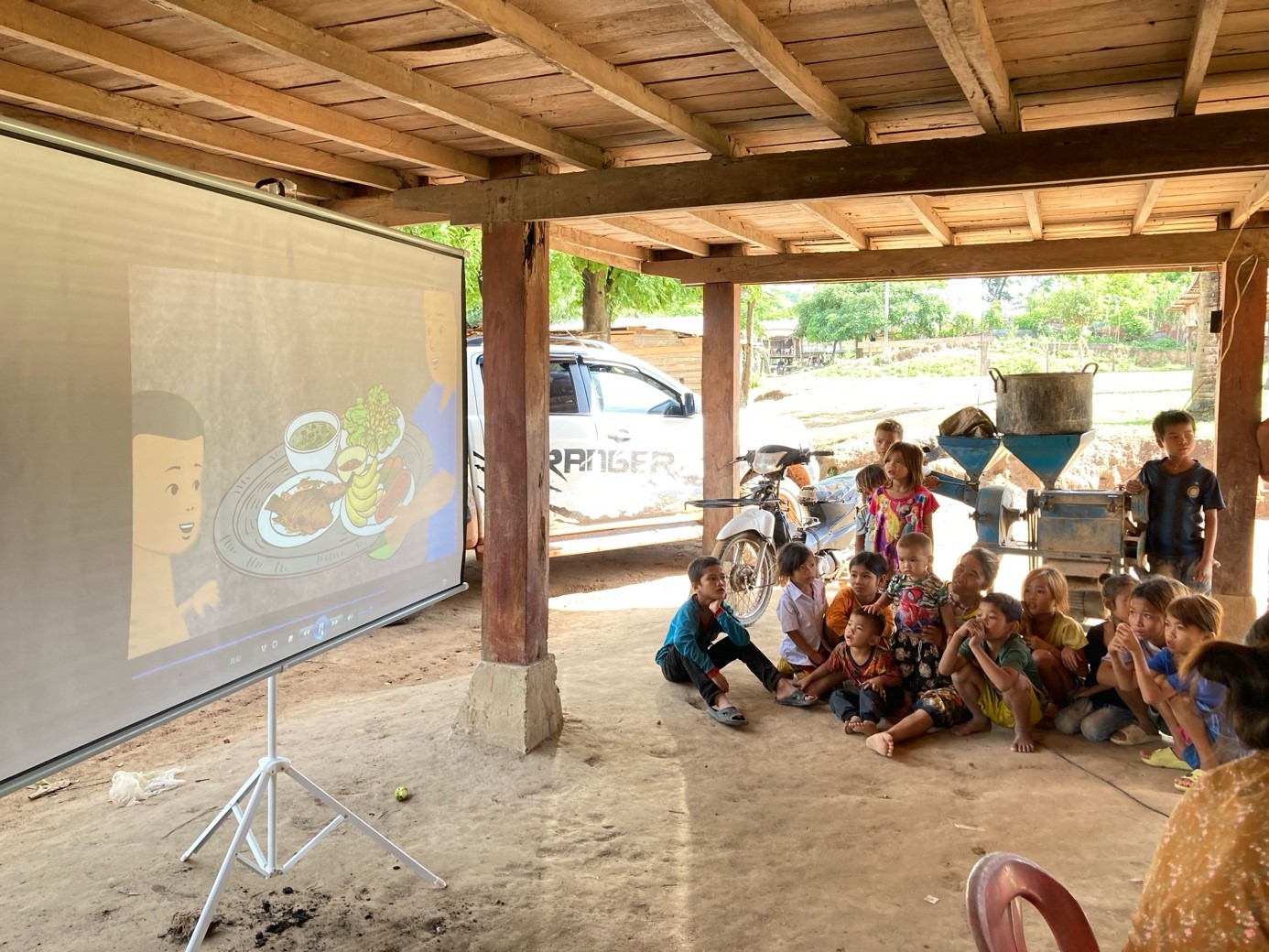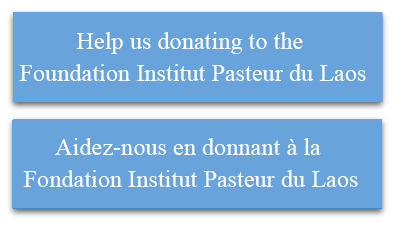The effectiveness of a short health education animation for improving nutrition intake in indigenous couples: a cluster randomized controlled trial
 Collaboration.
Collaboration.
Savannakhet Provincial Health Department.
Funding.
This study is financially supported by the Asia Development Bank (ADB).
Objectives.
Malnutrition has been recognized as one of the public health burdens. In Lao PDR, the research on malnutrition is always focusing on child undernutrition because the Sustainable Development Goals (SDGs) are targeted to reduce stunting and wasting among children. On the other hand, malnutrition in the adult population is always neglected. Thus, this study aims to understand the current health status of adult populations in the poorest villages and to make effective strategies for them to reduce the burden of malnutrition, and parasitic disease prevalence, and improve their hygiene.
Background.
Research on malnutrition in Lao PDR primarily focuses on child undernutrition with the aim of achieving the SDGs target of reducing stunting and wasting by 40% and 5%, respectively, among children under five years of age. However, there is no report on malnutrition prevalence in the adult population. In addition, some studies showed that helminth infection is prevalent in the southern part of Lao PDR, especially in rural areas where raw meat and fish are often consumed and sanitation and hygiene conditions are inadequate [1-5]. Moreover, people with helminth infections were found to be malnourished, hookworm infection being a leading cause of anemia [6- 9]. Therefore, educating the adult population on nutrition and parasite ecology is necessary to raise awareness and control parasitic diseases [3,8,10].
Methodology.
Ethical consideration.
Ethical approval was obtained from the Research Ethics Committee of the University of Health Sciences, Lao PDR. Before stool sample collection, blood test and anthropometric measurement, couples (husband and wife) were given an oral briefing on the objectives and the methodology of the study. The participants were informed that their participation in this study was voluntary, and they could withdraw at any time without giving any reason. They were informed that their identities and personal information were kept strictly confidential. For the participants who tested positive for parasite(s), antiparasite drugs were given. If they agreed to participate, the informed consent was signed by the literate participant. For the illiterate participant, their consent was obtained by their thumbprint on the informed consent form.
Study site and sample size.
This study was conducted at eight selected villages in Nong district, Savannakhet province. The first survey was performed in May 2023 and the second survey was in December 2023. The sample size was calculated based on the total population (35,446) with a confidence level of 95% and a margin error 5%. Thus, the minimum sample size was 380 people or 190 couples. The 190 couples were randomly divided into two groups, the intervention group (n=95 couples), and the control group (n=95 couples).
Data collection.
After obtaining informed consent, the individual (husband-wife) interview was performed by using a questionnaire to collect demographic data, latrine usage, household income/spending, livestock, daily activities, meal intake, drinking water, knowledge of malnutrition and intestinal parasites. Then, the anthropometric measurement and hemoglobin test were conducted.
The stool samples obtained at month 0 and month 6 were examined by using the Kato-Katz technique to detect the intestinal parasite eggs. The Kato-Katz standard operating procedures were described in the article [1]. The antiparasitic drug: a single dose of mebendazole 400 mg was provided by the health center staff to the participants who were infected with any intestinal parasites.
As an intervention, a short health education animation (for easy understanding) was shown for the intervention group while no animation was shown for the control group. If the participants did not understand the Lao language, village health volunteers or villagers who understood the Lao language translated the Lao into their local languages (Mangkong ethnic group). This media was uploaded on YouTube after finishing the project. All data were entered by using a Microsoft Excel file and analyzed by STATA software. The questionnaire was used two times (before and after six months) to compare their behavior, knowledge, and their attitude toward nutrition and intestinal parasites.
Results.
The first survey (baseline survey) was conducted in the Nong district, Savannakhet province in June 2023. A total of 364 adults were registered and participated in this study. Questionnaire surveys, stool examinations and hemoglobin tests were conducted. The study participants were randomly divided into two groups: 196 were in the intervention group while 168 were in the control group.
Stool examination was conducted by Kato-Katz method on 322 stool samples. found among the participants.
Detailed results can be found in the paper version of this report and in upcoming publications.
Discussion.
The study participants belonged to ethnic minorities and most of them spoke non-Lao languages and couldn’t understand the Lao language. Their educational level was limited: more than 60% had no school education. More than 80% of the participants had no latrines at their homes. Surprisingly, about 80% of the participants answered that they were always ill. The prevalence of intestinal helminths and anemia was also quite high. Those findings suggested that their sanitation, hygiene conditions and nutritional status were inadequate. The Lao Ministry of Health is trying to provide health services and health education but language barriers may exist among ethnic minorities.
Conclusion & Perspectives.
In 2023, 364 adults were included in this study in Nong district, Savannakhet province. The questionnaire survey, blood test (hemoglobin test) and stool examination for intestinal parasites were performed. We found that their educational status was limited, and their hygiene conditions were inadequate. More than 70% of them were infected with hookworm. In addition, more than half of them were anemic which suggests that their nutritional status was also inadequate. The short health education animation was shown to the intervention group. The second survey was just recently conducted in December 2023 to compare the difference between the intervention group and the control group on their knowledge, attitude and practice for the prevention of parasitic infections, and improvement of nutrition and hygiene conditions.
References.
1. Levecke, B, Cools, P, Albonico, M, et al. Identifying thresholds to classify moderate-to-heavy soil-transmitted helminth intensity infections for FECPAKG2, McMaster, Mini-FLOTAC and qPCR. PLoS Neglected Tropical Diseases, 14(7): e0008296, 2020.
2. Ngui, R, Ishak, S, Chuen, CS, et al. Prevalence and risk factors of intestinal parasitism in rural and remote West Malaysia. PLoS Neglected Tropical Diseases, 5(3): e974. 2011.
3. Phongluxa K, Xayaseng V, Vonghachack Y, et al. Helminth infection in southern Laos: High prevalence and low awareness. Parasites and Vectors, 6(1): 328. 2013.
4. Sayasone S, Odermatt P, Phoumindr N, et al. Epidemiology of Opisthorchis viverrini in a rural district of southern Lao PDR. Transactions of the Royal Society of Tropical Medicine and Hygiene, 101(1): 40–47, 2007.
5. Sayasone S, Vonghajack Y, Vanmany, M. Diversity of human intestinal helminthiasis in Lao PDR. Transactions of the Royal Society of Tropical Medicine and Hygiene, 103(3): 247–254. 2009.
6. Foy H, & Nelson G S. Helminths in the etiology of anemia in the tropics, with special reference to hookworms and schistosomes. Experimental Parasitology, 14(2) : 240–262. 1963.
7. Larocque R, Casapia M, Gotuzzo E, et al. Relationship between intensity of soil-transmitted helminth infections and anemia during pregnancy. American Journal of Tropical Medicine and Hygiene, 73(4) : 783–789, 2005.
8. Rajoo Y, Ambu S, Ai Y, et al. Neglected Intestinal Parasites, Malnutrition and Associated Key Factors: A Population-Based Cross-Sectional Study among Indigenous Communities in Sarawak, Malaysia. Indigenous Communities in Sarawak, Malaysia. PLoS ONE, 12(1): 170174, 2017.
9. Stephenson LS, Latham MC, Ottesen EA. Malnutrition and parasitic helminth infections. Parasitology, 121 Suppl: S23-38, 2000.
10. Bensley RJ, Brusk JJ. Impact of food preparation video exposure on online nutrition education in women, infants, and children (WIC) program participants: retrospective study. JMIR Formative Research, 3(1):e12508, 2019.
IPL publications in 2023.
Neutralization of African enterovirus A71 genogroups by antibodies to canonical genogroups. Volle R, Luo L, Razafindratsimandresy R, Sadeuh-Mba SA, Gouandjika- Valisache I, Horwood P, Duong V, Buchy P, Joffret ML, Huang Z, Duizer E, Martin J, Chakrabarti LA, Dussart P, Jouvenet N, Delpeyroux F, Bessaud M.J Gen Virol. 2023 Nov;104(11). doi: 10.1099/jgv.0.001911.
Arbovirus researchers unite: expanding genomic surveillance for an urgent global need. Gabriel Luz Wallau, Global Arbovirus Researchers United. Lancet Glob Health 2023. Lancet Glob Health 2023 Oct;11(10):e1501-e1502. doi: 10.1016/S2214-109X(23)00325-X.
The challenges of viral hepatitis elimination: a global response to a global problem. Antony P Black, Jack Wallace, Mawuena Binka, Zahid Ahmad Butt. In BMC Public Health (Vol. 23, Issue 1). BioMed Central Ltd. https://doi.org/10.1186/s12889-023-15960-w
Deforestation inhibits malaria transmission in Lao PDR: spatial epidemiology using Earth observation satellites. Matsumoto-Takahashi ELA, Iwagami M, Oyoshi K, Sasaki Y, Hongvanthong B, Kano S. Trop Med Health. Nov 2023, 51(1):60. doi: 10.1186/s41182-023-00554-4.
Low Prevalence of Schistosoma mekongi Infection and High Prevalence of Other Helminth Infections among Domestic Animals in Southern Lao People’s Democratic Republic. Sayasone S, Khattignavong P, Keomalaphet S, Prasayasith P, Soundala P, Sannikone S, Kumagai T, Phomhaksa S, Inthavong P, Matsumoto-Takahashi ELA, Hongvanthong B, Brey PT, Kano S, Iwagami M. Trop Med Infect Dis. July 2023, 8(7): 372. doi: 10.3390/ tropicalmed8070372.
Impact of precipitation on the prevalence of schistosomiasis mekongi in Lao PDR: Structural equation modeling using Earth observation satellite data. Matsumoto-Takahashi ELA, Kumagai T, Oyoshi K, Sasaki Y, Mizukami Y, Hongvanthong B, Brey PT, Kano S, Iwagami M. One Health. May 2023, 16: 100563. doi: 10.1016/j.onehlt.2023.100563.
Low seroprotection against diphtheria and tetanus in Lao adolescents. Vantava S, Hefele L, Virachith V, Vannachone S, Khounvisith V, Nouanthong P, Huebschen JM, Sayasone S, Black AP. Trop Med Int Health. May 2023. Tropical Medicine and International Health, 28(6), 501–506. https://doi.org/10.1111/tmi.13882.
A Six Years (2010-2016) Longitudinal Survey of the Four Serotypes of Dengue Viruses in Lao PDR. Balière C, Calvez E, Thiberge JM, Somlor S, Vandenbogaert M, Grandadam M, Caro V. Microorganisms. 2023 Jan 18;11(2):243. doi: 10.3390/microorganisms11020243. PMID: 36838207 Free PMC article.
Teaching activities.
Khattignavong P, Field Epidemiology Training (FET).
Iwagami M, Field work for health research and cultural difference in a developing country: A case study in Laos, St. Luke’s International University, Tokyo, Japan, 21 June 2023 (Online lecture for Master Course students).
Iwagami M. The Lao People’s Democratic Republic (Laos), University of the Ryukyus, Okinawa, Japan, 2 December 2022 (Online lecture for Master Course students).
Training activities.
Training is given by the team.
On-the-job training of Lao Military Personnel, Arboshield Plus Project:
Souphanick PHOMEEXAY (September 2022-February 2023).
Khamphout VORLASUK (March-August 2023).
Internship of an undergraduate student, National University of Lao:
Siliphone SOUVANNAVONG (August-September 2023).
Malaria PCR training for Lab staff of the Center of Malariology, Parasitology and Entomology (CMPE), Ministry of Health:
Phinnakone RATHSACHACK, Manysack PHOMMASANSACK. (October-November 2023).






